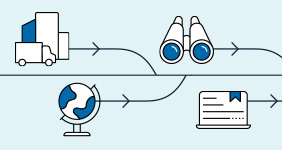Explore Economics
Gain the skills to make an impact
Today’s students need to build skills that help them to make a positive impact now and in the future. Study economics to better understand the world around you and build a career that tackles the big problems shaping people’s lives.
What jobs can you do if you study economics?
Embark on your academic journey. Studying economics can give you a framework for understanding the world, finding practical solutions to problems and making a difference. Find out about pathways to economics and where it can take you.

Explore these resources

Economics: gain the skills to make an impact.
Start learning now, no matter your stage!
Video transcripts
What impact can you make as an economist?
Maddy Terrell
So I think working as an economist, I don’t know about you, but I was shocked at the amount of impact you can have in your role and by impact I mean influencing people’s decision making or influencing policy outcomes to improve the welfare of the Australian people or broader society as well.
Natasha Cassidy
The people I know that are economists do such a wide range of things. So you might be working and thinking about what the impact of climate change or geopolitical shocks might be on the Australian economy; you might be looking at housing affordability or improving education outcomes for preschoolers. And then I think about friends of mine that are economists that are in the private sector – they’re thinking about the cost benefit analysis of big investments projects for firms.
Emma Chow
So I’m working in the Education team so one of the really big problems we’re trying to address is this declining size and diversity in the economics student population. It’s a really complex issue so I guess you need to look into the data and do some research to really understand what are the drivers behind this.
Chris Schwartz
I guess a big impact that the team that I’m in, the media team, tries to have is how can we explain the decisions the we or the RBA make to as broad of an audience as possible.
So being able to work to explain those in a way that people will be able to understand is probably the most rewarding for sure and impactful thing that I’ve worked on.
Geneve Bullo
Having impact and influence is one of the highlights of a career in economics.
What problems can you tackle as an economist?
Geneve Bullo
I think as an economist, throughout your career, you’re always going to be answering different questions, the project that you’re working on is probably going to be different to the last and you’re going to be picking up different topics of expertise.
Natasha Cassidy
I think for me I have to think back to the big events that happened internationally during my time as an economist and most recent was obviously the pandemic and at the time my role was leading a team where we trying to think about what would be the outlook for the labour market and inflation over that period.
If you remember sort of in those early days of 2020, you had these pictures of people queuing outside Centrelink because their hours had been drastically cut or so forth at the same time there was really strong demand for health care workers and the models that we normally use well they’re not set up to answer these kinds of questions and so we sort of had to the team had to sort of think about things, throw the playbook out if you like, and think about things about it more intuitively.
Ashwin Clarke
One of the most memorable things for me was analysing how the trade tensions we faced over the past few years have impacted Australia and one of the really unique things that we can bring as an institution that I realised at that time was it’s not just about the models, and we had really good models to kind of think through these problems, but we complemented that with information from people who are feeling it on the ground.
Maddy Terrell
With a career as an economist you can tackle all sorts of problems. It’s not just the obvious things like bringing inflation down or keeping unemployment low, but it also includes a range of things like other big issues facing society. Things like climate change, inequality, the gender pay gap and the impacts of artificial intelligence.
What does an economist do?
Maddy Terrell
So a typical day as an economist usually starts with a team meeting where we talk about what we’ve got for the day ahead We then often have a data release. And so data is the backbone of the work we do as an economist.
Geneve Bullo
As an economist you’re always constantly working with data but also more importantly how to communicate to that to your audience.
At the Bank we have a lot of data and a lot of questions that we need to answer so essentially what we’re doing is that all our data and evidence are little puzzle pieces in a story about the Australian economy
And so in my role kind of what I have to do is square all those pieces of information and come up with an narrative about how businesses are faring right now after a few years of challenges.
Ashwin Clarke
Some of the great things about a career in economics are that it gives an entry into a really wide range of fields. Just to take my friends that I went to university with as an example: one is a product executive who is responsible for creating new products for a healthcare company, another is an economics adviser at the most senior levels of government; and another is a data scientist who’s able to analyse the vast reams of data produced by transportation companies. So the most interesting job by far is a friend of mine who is a board game designer and he’s used economics to fine tune the mechanics of his games to make them interesting and keep people playing.
What's happening in the economy right now?
Hi, I’m Madi. Thanks for joining us! Let’s look at what’s going on in the economy.
In our May video, we talked about tariffs and global uncertainty — two key forces that have been shaping the global economy this year.
Since then, the United States has made deals with many of its trading partners. Most of these agreements include a US tariff rate between 15 and 20 per cent. Australia’s tariff rate, however, is still 10 per cent.
To put that in perspective, the average tariff rate in the US is now the highest it’s been since the 1930s, during the Great Depression — a time when global trade was heavily restricted.
Let’s do a quick recap.
A tariff is a tax placed on goods imported from another country, which makes those items more expensive. When prices go up, people look for cheaper options, like buying similar products produced locally, or from other countries where tariffs are lower.
Higher tariffs can slow down economic activity around the world, including in Australia. To understand how, let’s use a concept you might have heard before: Aggregate demand. This shows the total spending in the economy — including household consumption, businesses investment, government spending, and net exports.
Here’s how tariffs can affect aggregate demand.
First, tariffs make imported goods more expensive, so people tend to buy less of them. All else equal, countries facing tariffs sell less of these goods, which reduces their export revenue and could slow their economic growth.
Second, trade tensions create significant uncertainty. When households and businesses aren’t sure what’s going to happen, they might play it safe and decide to save instead of spending. For example, your family might delay buying a new tv or going on a holiday. Or suppose you’re a coffee shop owner who wants to buy a new coffee machine. But since the economic environment is uncertain, you might decide to wait. When these decisions are all added up, it could lead to slower growth in consumption and investment which would also slow economic activity.
This graph shows how uncertainty has changed over time. There’s still a lot of uncertainty, but it’s not as much as before.
So, how has the global economy responded to higher tariffs so far?
Well, businesses in other countries are changing how they trade, and that’s helping to reduce the impact of tariffs on economic activity.
For example, countries like China are finding new markets to sell their products. Since April, China’s exports to the United States have declined but exports to other advanced economies and east Asia have increased.
We’ve talked about the impact of tariffs on economic activity, but what about the effect on inflation, like in Australia?
To understand this, we need to look at both aggregate demand as well as aggregate supply, which shows the total amount of goods and services the economy can produce.
Tariffs on exports from Australia, and on our biggest trading partners, along with heightened uncertainty can cause aggregate demand to fall. This puts downward pressure on prices across a range of good and services and leads to lower inflation.
But there’s also a supply-side effect. Tariffs can disrupt global supply chains, making it harder or more expensive to get parts from overseas. It can also lower productivity and raise the cost of production. All of this means the economy can’t produce as much as before. This causes the aggregate supply to decrease which pushes up prices.
The key thing to note is that the demand and supply effects are pulling in opposite directions. One will decrease inflation, and the other will increase it.
Let’s put it all together. While the supply channel will push up prices, we think the demand channel will be stronger, represented by a larger shift in the demand curve. So overall, we expect these tariff related effects to put a bit of downward pressure on prices.
So, a lot is happening in the global economy at the moment. But what about the Australian economy?
The RBA’s Monetary Policy Board decided to lower the cash rate to 3.60 per cent at its August meeting.
Why did the Board decide to lower the cash rate? Let’s take a moment to zoom out.
The RBA’s monetary policy decisions are guided by two key objectives, which is sometimes called “a dual mandate”.
The first objective is price stability, or low and stable inflation.
And the second is full employment, which means that people who want a job can find one without having to search for too long.
So, let’s take a look at how inflation and the labour market have evolved over time.
In this chart, the blue line shows underlying inflation over time. Underlying inflation is different to the headline consumer price inflation that you might hear reported in the news because it excludes unusually large price changes. By taking out very large price increases and declines, underlying inflation provides a better understanding of overall inflation trends.
Inflation started to rise in 2021, driven by strong demand, supply chain disruptions, and higher global energy prices. In response, the RBA raised the cash rate from near zero to 4.35 per cent over 2022 and 2023.
The tightening of monetary policy helped bring demand and supply closer to balance. As a result, inflation has come down significantly. The latest data show that underlying inflation was 2.7 per cent in the June quarter, its lowest level since late 2021 and within the RBA’s target band of 2-3 per cent. This is a major milestone and shows that monetary policy has been working as intended.
Importantly, the labour market has been resilient over this period. In this chart, the red line shows the unemployment rate over time. The unemployment rate tracks people who are actively looking for a job but don’t have one.
Despite higher interest rates, the unemployment rate stayed low, sitting at 4.3 per cent in June, only slightly higher than earlier in the year. Labour force participation is also strong, and employment continues to grow.
This is a good result for Australia - inflation has come down without a sharp rise in unemployment.
Let’s sum up. The Board decided it was appropriate to lower the cash rate. Underlying inflation has continued to decline back towards the midpoint of the 2–3 per cent target range and labour market conditions have eased only slightly, and as expected.
However, the outlook remains uncertain, and the Board will continue to watch the data closely and monitor how risks are evolving. The Board noted that monetary policy is well placed to respond to global developments if they were to impact growth and inflation in Australia.
So, that’s our summary of current economic conditions. For more information on tariffs, or other student resources, check out the links in the description. Thanks for watching.


